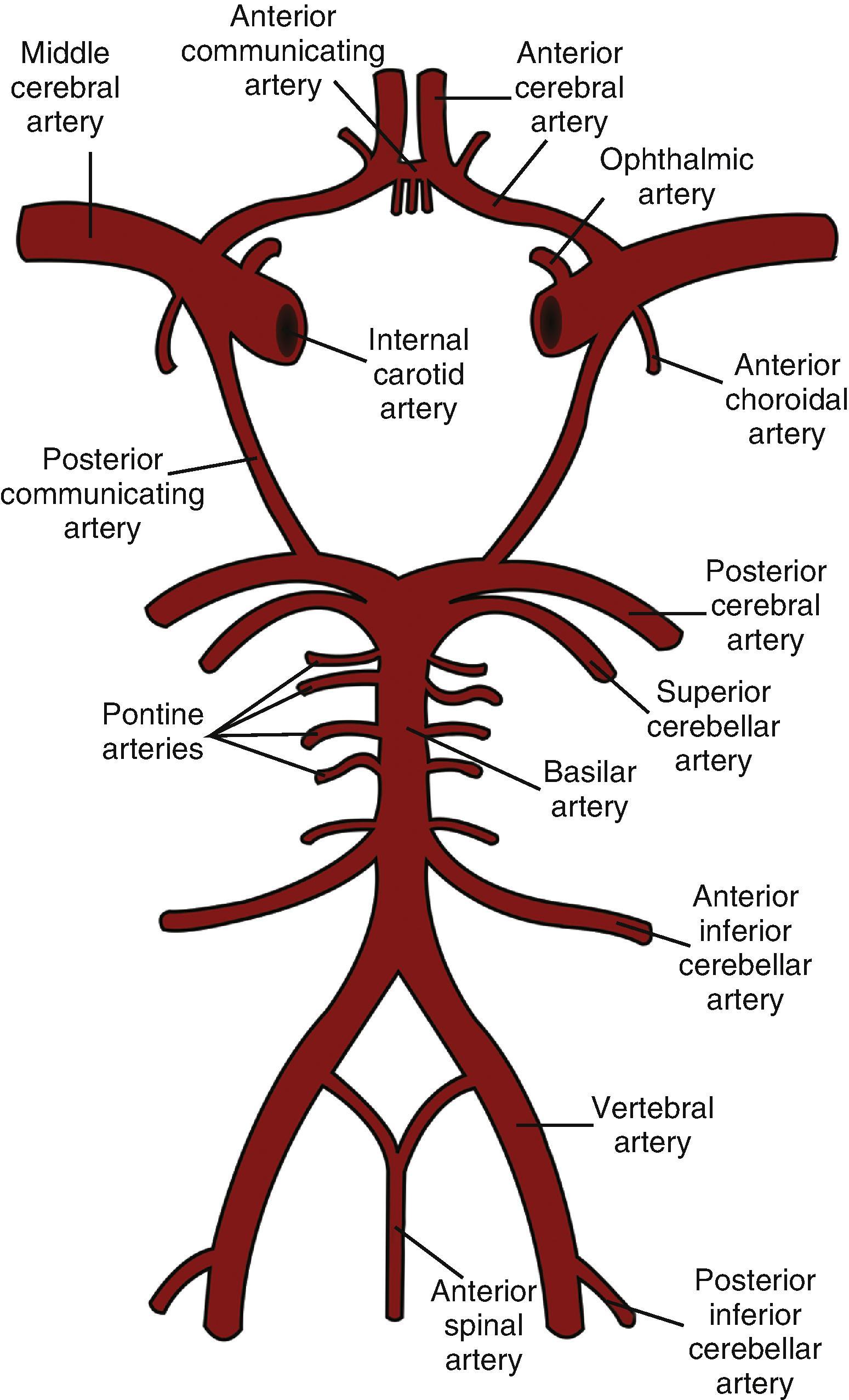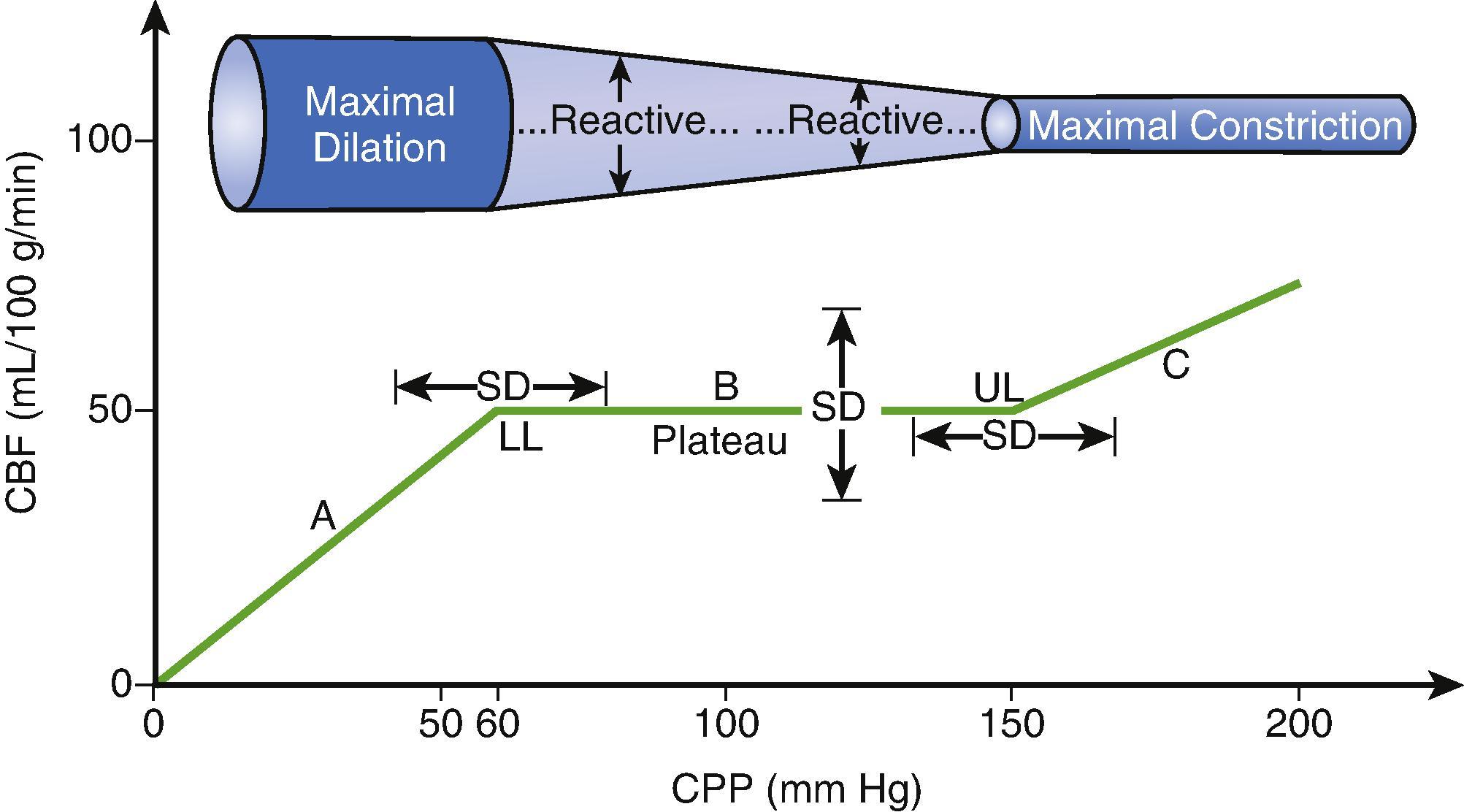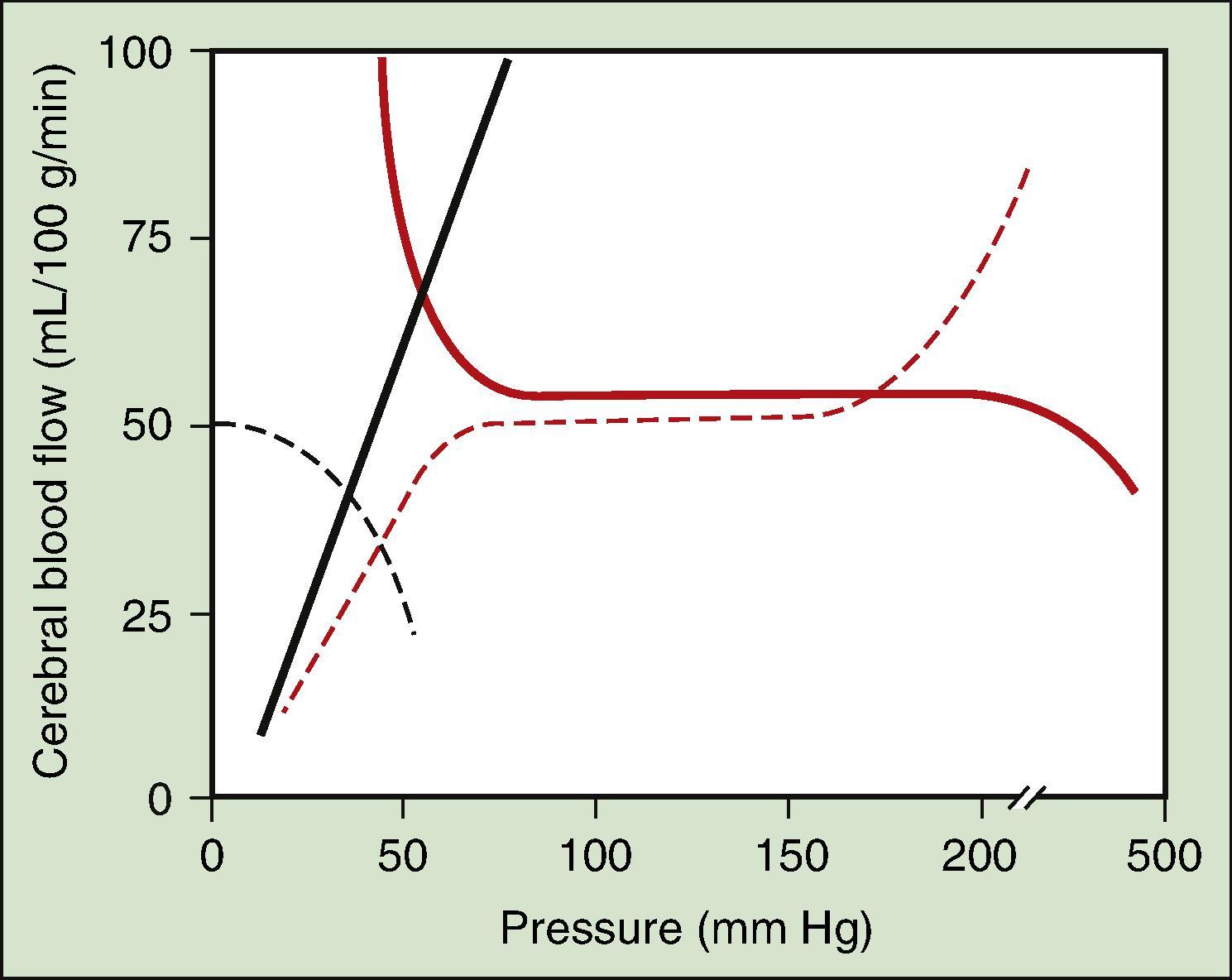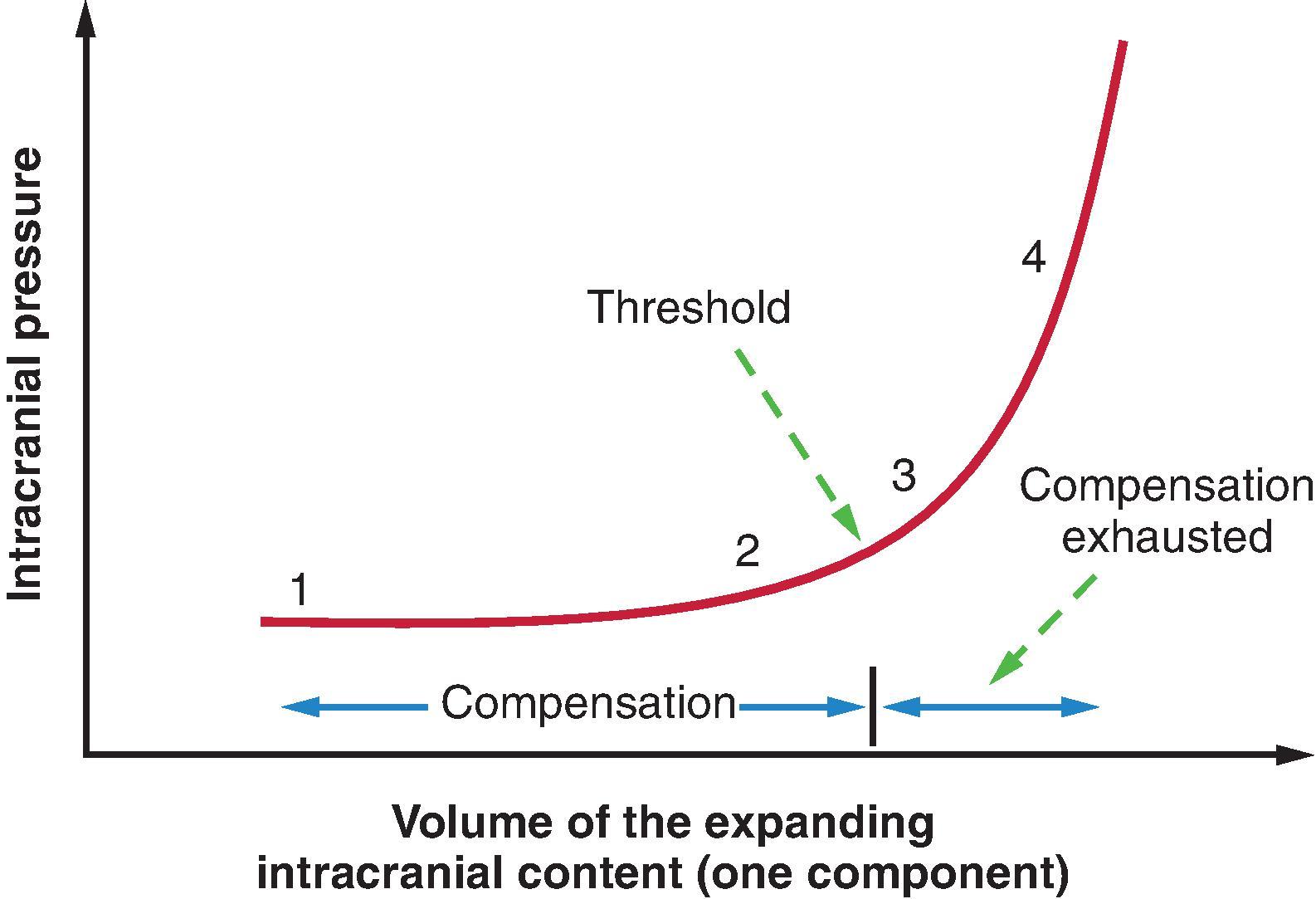Physical Address
304 North Cardinal St.
Dorchester Center, MA 02124
The central nervous system (CNS) deserves special consideration in the perioperative setting for several reasons. First, anesthesia care is often required for patients undergoing treatment for CNS diseases, such as intracranial tumors or aneurysms, carotid disease, or diseases of the spine. Second, anesthesia providers commonly encounter patients with concurrent CNS diseases (e.g., Parkinson disease or prior stroke) who present for nonneurologic procedures. Third, neurocognitive dysfunction or other neurologic complications, such as stroke and delirium, can occur after surgery. Finally, the CNS is highly vulnerable to ischemia, as it is metabolically active with little oxygen reserve and is therefore sensitive to hypoxia even for very brief periods. The latter is especially important in vulnerable patients with altered cerebrovascular pathophysiology leading to poor regulatory reserve of cerebral blood flow (CBF). This chapter discusses the relevant knowledge base and clinical care needed when taking care of patients with CNS diseases or who are at risk for neurocognitive complications in the perioperative setting.
Conceptually, the cranium is divided into supratentorial and infratentorial compartments. The supratentorial compartment contains the cerebral hemispheres and diencephalon (thalamus and hypothalamus), and the brainstem (midbrain, pons, and medulla) and cerebellum make up the infratentorial compartment. For intracranial surgery, the location of the lesion has important implications for operative position and anesthetic management. For example, antiepileptic medications are commonly considered during supratentorial, rather than infratentorial, brain tumor resection. In addition, intracranial lesions may be classified as either intraaxial or extraaxial, defined as within or outside the brain parenchyma, respectively. The location of intraaxial mass lesions is particularly relevant, as some lesions may compromise eloquent areas such as the language centers and motor cortex of the brain. In this case functional preservation during surgery becomes a critical focus.
The arterial blood supply to the brain is through the left and right internal carotid arteries (anterior circulation) and the vertebrobasilar system (posterior circulation). Anastomoses between these vessels form the circle of Willis ( Fig. 30.1 ) and create a collateral blood supply to protect against focal ischemia. However, this ring should not be assumed to be complete in all patients; approximately 50% or more of the population has an abnormal circulation, implying that collateralization may not be complete. The clinical significance of an abnormal circle of Willis may depend on the pattern of the abnormality and coexisting cerebrovascular diseases. Anesthesia providers should carefully maintain adequate cerebral perfusion pressure (CPP) in anesthetized surgical patients with hemodynamically significant obstructive cerebrovascular lesions (e.g., carotid stenosis) or abnormal collateral circulation. Unfortunately, this information is not available in most patients; therefore consistently avoiding relative hypotension in the perioperative period is a reasonable approach.

There are 12 pairs of intracranial nerves, each with a unique distribution and sensorimotor and autonomic function. Some neurosurgical procedures can potentially jeopardize specific intracranial nerves during surgery. For example, resection of acoustic neuroma can injure or sacrifice the vestibulocochlear nerve. Intracranial nerves can be monitored intraoperatively to facilitate timely detection of reversible injury and theoretically prevent permanent deficit. If intraoperative neuromonitoring is used, the anesthesiology and neurophysiologic monitoring teams need to be in close communication to ensure that appropriate equipment is available and a compatible anesthesia technique is chosen to facilitate monitoring, with the goal of maintaining a stable anesthetic depth that avoids overly suppressing neurophysiologic function. Anesthetic technique should be tailored to the intraoperative neuromonitoring used. For example, volatile anesthetic agents are typically minimized during somatosensory and motor evoked potential monitoring, and neuromuscular blocking agents should be avoided when motor evoked potentials are used. Glossopharyngeal nerve and hypoglossal nerve monitoring require placement of monitoring needles inside of the mouth, and caution should be taken until all needles are removed. Vagus nerve monitoring requires the placement of a special endotracheal tube with electrodes. If motor evoked potentials are used, a bite block must be placed to avoid trauma to the tongue and oropharynx, because masseter and temporalis muscle contraction commonly occur during stimulation.
The anatomic and functional integrity of the blood–brain barrier has important clinical implications. The blood–brain barrier is composed of capillary endothelial cells with tight junctions that prevent free passage of electrolytes, macromolecules, or proteins. In contrast, lipid-soluble substances (carbon dioxide, oxygen, anesthetic agents) cross the blood–brain barrier easily. The blood–brain barrier may be disrupted in the event of hypertensive crisis, trauma, infection, arterial hypoxemia, severe hypercapnia, tumors, and sustained seizure activity. Osmotic therapy (e.g., mannitol) for brain edema, intracranial hypertension, or intraprocedural brain relaxation relies on an intact blood–brain barrier in order to move the free water from the brain parenchyma to the intravascular space.
Normal CBF is approximately 50 mL/100 g/min and represents 12% to 15% of total cardiac output. The brain, representing 2% of the body weight, receives a disproportionately large share of cardiac output because of its high metabolic rate and inability to store energy. As preservation of oxygen delivery is critical, the brain is equipped with robust regulatory mechanisms to regulate blood flow. Physiologic measures that regulate CBF include the following: (1) cerebral metabolic rate via neurovascular coupling, (2) CPP via cerebral autoregulation, (3) arterial blood carbon dioxide and oxygen partial pressure (Pa co 2 and Pa o 2 , respectively) via cerebrovascular reactivity, (4) sympathetic nervous activity, (5) cardiac output, and (6) anesthetic agents directly. Different regulatory mechanisms may exert distinctive and sometimes opposing effects on CBF; however, these effects are integrated at the level of cerebral resistance arteries/arterioles to determine the CBF. ,
Cerebral metabolic rate of oxygen (CMRO 2 ) is often used as an index of the cerebral metabolic activity. CMRO 2 and CBF are closely related—an increase or decrease in CMRO 2 results in a proportional increase or decrease in CBF, respectively. This mechanism is known as neurovascular coupling or cerebral metabolism-flow coupling. In the perioperative setting CMRO 2 can be reduced by hypothermia and most intravenous anesthetic drugs, which produces a coupled reduction in CBF in healthy brains (CBF decreases 7% for every 1°C decrease in body temperature below 37°C). In contrast, CMRO 2 and therefore CBF may be dramatically increased by seizure activity.
CPP is the difference between mean arterial pressure (MAP) and intracranial pressure (ICP) or central venous pressure, whichever is greater. How CPP affects CBF is determined by cerebral autoregulation, which is a mechanism that maintains a relatively stable CBF in the face of a fluctuating CPP as a result of cerebral vasoconstriction or vasodilation in response to an increase or decrease in CPP, respectively. That is, the simultaneous and proportionate changes in CPP and cerebrovascular resistance caused by cerebrovascular pressure reactivity lead to a stable CBF. However, as static cerebral autoregulation takes minutes to take effect, a rapid increase or decrease in MAP may be associated with a brief period of cerebral hyperperfusion or hypoperfusion, respectively.
The cerebral autoregulation curve has three portions that are the plateau and the lower and upper limits of autoregulation ( Fig. 30.2 ). The lower limit is the CPP level below which the CBF decreases along with a decreasing CPP. In contrast, the upper limit is the CPP level above which the CBF increases along with an increasing CPP. The plateau is the CPP range between the lower and upper limits where CBF remains stable (approximately 50 mL/100 g/min in awake adults and lower in anesthetized adults). The frequently quoted limits of autoregulation are a lower limit of 60 mm Hg and an upper limit of 150 mm Hg. However, it is important to recognize that although these numbers may apply to young and healthy humans, there is significant variation, and they may not apply in patients with various medical and surgical comorbidities. For example, chronic uncontrolled hypertension or sympathetic stimulation shifts the autoregulatory curve to the right, and these patients require a higher minimum CPP to maintain adequate CBF. Autoregulatory curves are an individualized phenomenon; perioperative blood pressure or CPP management should incorporate individual variation and factors to avoid jeopardizing cerebral perfusion.

Cerebral autoregulation may be impaired in various circumstances. It can be abolished after traumatic brain injury and intracranial surgery. As a result, CBF becomes pressure passive, implying that it no longer remains stable across the autoregulatory CPP range and instead changes along with changes in CPP. Severe hypercapnia, often as a result of hypoventilation, can also impair cerebral autoregulation. Inhaled anesthetic agents are potent cerebral vasodilators and impair autoregulation to varying degrees depending on the dose used. In contrast, intravenous anesthetic agents do not typically disrupt this regulatory mechanism. In circumstances where cerebral autoregulation is impaired it is important to carefully control CPP because changes in CPP lead directly to changes in CBF, leading to either inadequate or overzealous perfusion of the brain.
Both Pa co 2 and Pa o 2 are powerful modulators of CBF, reflecting a robust cerebrovascular Pa co 2 and Pa o 2 reactivity. Changes in Pa co 2 produce corresponding and same directional changes in CBF between a Pa co 2 of 20 and 80 mm Hg ( Fig. 30.3 ). CBF increases or decreases approximately 1 mL/100 g/min, or 2%, for every 1 mm Hg increase or decrease in Pa co 2 from 40 mm Hg. Such changes in CBF reflect the effect of carbon dioxide–mediated alterations in perivascular pH that lead to cerebral arteriole dilation or constriction. The Pa co 2 -related change in CBF only lasts for about 6 to 8 hours because of the compensatory change in bicarbonate (HCO 3 − ) concentration. Both extreme hyperventilation and hypoventilation should be avoided, as they lead to cerebral hypoperfusion and hyperperfusion, respectively. There is evidence to suggest that prolonged and aggressive hyperventilation after traumatic brain injury is associated with poorer neurologic outcome. In contrast, decreases in Pa o 2 below a threshold value of about 50 mm Hg result in an exponential increase in CBF (see Fig. 30.3 ), likely a compensatory mechanism to maintain cerebral oxygen delivery. Cerebral oxygen delivery equals arterial blood oxygen content times CBF. Therefore if arterial blood oxygen content decreases because of acute anemia or hemoglobin desaturation, CBF can increase to maintain cerebral oxygen delivery.

Intravenously administered anesthetic agents such as propofol and thiopental cause simultaneous reduction of CMRO 2 and CBF. The effect of intravenous anesthetics on CBF is attributed to neurovascular coupling; that is, the decrease in CMRO 2 leads to a corresponding decrease in CBF. The reported effects of ketamine on cerebrovascular physiology and ICP have varied, which likely reflects different research study conditions. When ketamine is given on its own without control of ventilation, Pa co 2 , CBF, and ICP all increase, whereas when given in the presence of another sedative/anesthetic drug in patients whose ventilation is controlled, these effects were not observed. Because of this controversy, however, ketamine is often avoided in patients with known intracranial disease or increased ICP.
Benzodiazepines and opioids decrease CMRO 2 and CBF, analogous to propofol and thiopental, although to a lesser extent. However, if these medications result in respiratory depression and elevation of Pa co 2 , the opposite effect may occur. Opioids should be used with caution in patients with intracranial disease because of their depressant effects on consciousness and ventilation with associated increases in Pa co 2 , and therefore ICP.
Alpha-2 agonists (e.g., clonidine and dexmedetomidine) are unique sedatives in that they do not cause significant respiratory depression. They reduce arterial blood pressure, CPP, and CBF with minimal effects on ICP. Alpha-2 agonists can be used intraoperatively to reduce the dose of other anesthetic agents and blunt hemodynamic responses, or postoperatively as sedatives and to attenuate postoperative hypertension and tachycardia.
In contrast to intravenous anesthetics, volatile anesthetic agents are potent cerebral vasodilators. At low doses, this vasodilation is balanced by a reduction in CBF induced via flow metabolism coupling and a reduction in CMRO 2 . However, when administered during normocapnia at concentrations higher than 0.5 minimum alveolar concentration (MAC), desflurane, sevoflurane, and isoflurane induce dose-dependent vasodilation and increases in CBF even though CMRO 2 is decreased. Therefore volatile anesthetic agents produce divergent changes in CMRO 2 and CBF that are distinct from intravenous anesthetic agents, particularly at high doses. When used in isolation, nitrous oxide increases CBF and possibly CMRO 2 ; however, these effects appear to be attenuated by the coadministration of other anesthetic agents.
ICP and brain relaxation are related but distinct. ICP is the pressure measured inside of the cranium with the cranium closed/intact. Brain relaxation is the volumetric relationship between the brain and intracranial space and the tactile feeling of the firmness of the brain by the surgeon with the cranium opened. When the cranium is opened, the ICP equals the atmospheric pressure (i.e., zero); however, the brain may or may not be regarded as relaxed. Nonetheless, the management strategies for ICP and brain relaxation are similar.
The intracranial compartment normally contains three components: (1) brain matter, (2) cerebrospinal fluid (CSF), and (3) blood. Increases in any of these components or the addition of a pathologic lesion (e.g., tumor) can result in an elevated ICP, normally defined as a sustained increase of ICP greater than 15 mm Hg. Marked increases in ICP can decrease CPP, and therefore CBF, to the point of causing cerebral ischemia. However, several compensatory physiologic mechanisms can help to reduce ICP, including compensatory reduction of other intracranial components such as translocation of CSF from the intracranial space to the extracranial space. When these compensatory mechanisms are exhausted, ICP starts to rise and cerebral blood vessels are eventually compressed ( Fig. 30.4 ). It is important to differentiate CBF from cerebral blood volume (CBV) because the former is a dynamic concept representing flow, whereas the latter is a static concept representing the intracranial blood volume. These two terms are related but not interchangeable. The treatment of intracranial hypertension is primarily via the reduction of various intracranial components, including CBV ( Box 30.1 ). Theoretically, the reduction of CBV should not compromise CBF; otherwise, the brain will experience hypoperfusion or ischemia.

Decrease Cerebral Blood Flow
Intravenous anesthetic drugs are preferred
Decrease CMRO 2 (propofol, barbiturates)
Employ hyperventilation
Avoid cerebral vasodilators
Avoid extreme hypertension
Increase Venous Outflow
Elevate head
Avoid constriction at the neck
Avoid PEEP and excessive airway pressure
External ventricular drain
Lumbar drain
Head elevation (translocation of intracranial cerebrospinal fluid)
Acetazolamide (Diamox)
Osmotic therapy (mannitol, hypertonic saline)
Furosemide (Lasix)
Prevention of ischemia and secondary edema
Dexamethasone to reduce peritumoral vasogenic edema
Decompressive Craniectomy
Become a Clinical Tree membership for Full access and enjoy Unlimited articles
If you are a member. Log in here